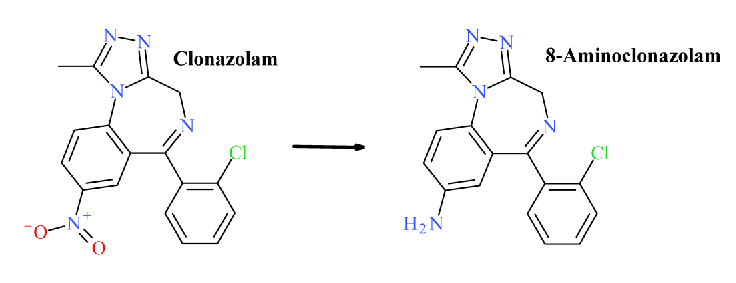Clonazolam (also called clonitazolam) first emerged in the recreational drug supply in 2014 (Europe) and 2016 (United States). Like many NPS, clonazolam was first synthesized during drug development in 1971 but was never approved for therapeutic use. Clonazolam is the triazolo– counterpart to clonazepam (Klonopin, Rivotril). Clonazolam appears in various drug preparations, including powders, tablets (i.e. counterfeit pharmaceuticals), liquids, and blotters. Clonazolam has been linked to adverse events resulting in hospitalization or death and is commonly reported in combination with other drugs and/or NPS, including benzodiazepines and opioids. Trend reports developed by NPS Discovery previously indicated a decline in clonazolam positivity in Q3 2020. However, recent developments show that the positivity of clonazolam is currently increasing based on new data collected after testing for its metabolite.
Assessments of drug prevalence and positivity are contingent on accurate characterization of drug targets within specific samples. These assessments include consideration of the analytical methods used for drug testing and the drug species (e.g. parent drug, metabolite) targeted during method development and/or data processing. Nitro–group–containing benzodiazepines (e.g. clonazolam, clonazepam) are metabolized in the body to amino– counterparts (e.g. 8-aminoclonazolam, 7-aminoclonazepam). Additionally, instability of these drugs can lead to the production of these same amino– species. Therefore, data-mining for 8-aminoclonazolam was conducted on all samples analyzed in 2019 and 2020 to re-evaluate the positivity of clonazolam in our sample populations. The results indicate that the positivity of clonazolam was previously underreported when targeting only the parent drug and 8-aminoclonazolam appears to be a more appropriate biomarker for accurate determination of clonazolam use.
DOWNLOAD THE ALERT
November 5, 2020
Updated Trend Reporting for the NPS Benzodiazepine Clonazolam Based on Data-Mining for 8-Aminoclonazolam









